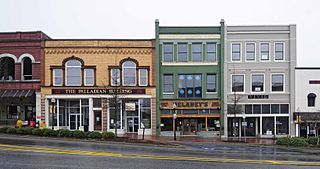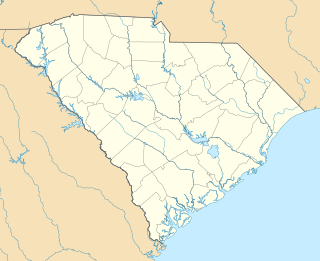
The Dillon County Courthouse, built in 1911, is a historic courthouse located at 301 West Main Street in the city of Dillon in Dillon County, South Carolina. It was designed in the Classical Revival style by Darlington native William Augustus Edwards who designed eight other South Carolina courthouses as well as academic buildings at 12 institutions in Florida, Georgia and South Carolina. Dillon County was created in 1910 and this is the only courthouse it has ever had. On October 30, 1981, it was added to the National Register of Historic Places. It is located in the Dillon Downtown Historic District.

The Apex Historic District is the historic commercial and residential center of Apex, North Carolina, a satellite town of the state capital Raleigh. The district revolves around Salem Street, the main thoroughfare in downtown Apex. In 2007, CNNMoney.com ranked Apex as the 14th best place to live in the United States. The report cited the Historic District as one reason for the award and described the district as "quaint, impressively intact, and with an array of commercial and residential buildings now serving visitors and residents alike." On March 17, 1994, the Apex Historic District was listed on the National Register of Historic Places. The district boundaries were expanded in 1995, 2002, and 2008, and include Hunter, Center, Chatham, Cunningham, Holleman, and Hughes Streets.

The James W. Hamer House is a historic home located near Little Rock, Dillon County, South Carolina. It was built in 1910-1911, and is a large two-story, three bay, brick-veneered Neo-Classical Revival style residence. It has four symmetrically-placed exterior end brick chimneys. The front facade features an Ionic order pedimented portico supported by two sets of paired brick columns. Also located on the property are several agricultural outbuildings and a mature pecan orchard that was likely planted by about 1920. It was the home of James Willis Hamer, farmer, state representative, and state senator of Dillon County during its first half-century.

The Pratt Street Historic District of Hartford, Connecticut, encompasses all of Pratt Street, between Main and Trumbull Streets, in the city's downtown. This block, which includes 15 buildings, is the only place in the city where its typical early 20th-century streetscape is retained. All of the buildings in the district were built between 1830 and 1928, a significant number of them designed by major local architects. The district was listed on the National Register of Historic Places in 1983.

Spartanburg Historic District is a district in downtown Spartanburg, South Carolina It was named to the National Register of Historic Places in 1983. The district was expanded in 2000.

The Morris Downtown Commercial Historic District is a historic district in downtown Morris. The district includes 116 buildings and a monument; 105 of these are commercial buildings, and 87 are contributing properties to the district.

Alderman's 20 Stores in One, also known as The Belk Building, is a historic commercial building located at Manning, Clarendon County, South Carolina. It was built in 1919, and is a two-story red brick building or two-part commercial block with a flat roof and parapets. The main façade of the building features a metal entablature supported by brackets and ornamented by recessed panels. Constructed by David W. Alderman, a wealthy Clarendon County lumber merchant and entrepreneur, the building was the first shopping mall in the county and is the largest storefront in the main business section of downtown Manning. Belk operated from the building from 1955 to the late-1980s.

Manning Commercial Historic District is a national historic district located at Manning, Clarendon County, South Carolina. The district encompasses 46 contributing buildings and 1 contributing object in the central business district of Manning, county seat for Clarendon County. Manning's downtown is dominated by its 1909 Neo-Classical, red brick courthouse set at the center of a landscaped courthouse square. The commercial district is characterized by one- and two-part commercial block buildings, many of them brick, that were constructed during the late-19th and early-20th century. The buildings are characterized by oblique and angled entrances, intriguing decorative cornices and corbeling, and a preponderance of parapeted rooflines give the Manning Commercial Historic District a clear and unmistakable association with the architecture typical of the early-20th century. In addition to the courthouse, other notable buildings include the U.S. Post Office and Federal Building, Coffey-Rigby Livery Stable, Clarendon Furniture Store, Leonard Building, Manning Hotel, Brailsford Grocery / Schwartz Building, Cut Rate Drug Store, and Pure Oil Service Station.

Darlington Downtown Historic District is a national historic district located at Darlington, Darlington County, South Carolina. The district encompasses 21 contributing commercial buildings in the central business district of Darlington, and built between about 1870 and 1935. The one, two, and three-part commercial buildings exhibit typical turn-of-the-20th century building styles, with brick detailing and, in some cases, cast-iron storefronts. Notable buildings include the Hill Building, Coggeshall Building, McLellan's Dept. Store, Wolfram Building, Jewel's Deluxe Cafe, Coleman Building, Manne Building, "The Darlington News" Building, and Bank of Darlington.

Meekins Barn is a historic tobacco barn located near Floydale, Dillon County, South Carolina. It was built before 1935, and is an example of a log tobacco barn. It is a large, five -"room" log barn with a metal-covered gable roof. The building has an arched firebox on the left elevation, a brick foundation reinforced by concrete, and weatherboard has been added between the logs. The gable ends are also weatherboarded.

Latta Downtown Historic District is a national historic district located at Latta, Dillon County, South Carolina. The district encompasses 13 contributing buildings in the central business district of Latta. The buildings were erected between about 1895 and 1928. They include buildings that housed a variety of mercantile establishments such as grocery stores, drugstores, a hotel, two banks, and several dry goods stores concentrated in a block east of the railroad on Main Street. Notable buildings include the Parham Building, McMillan Building, Cox Building, and Kornblut's Department Store.

Latta Historic District No. 1 is a national historic district located at Latta, Dillon County, South Carolina. The district encompasses 47 contributing buildings in a primarily residential section of Latta. The buildings were erected between about 1890 and 1930. The houses are mostly one- to two-story frame residences with late Victorian era details. In addition, the district has examples of local usage of neo-classical details and more sophisticated examples of the Neo-Classical style. Early 20th century bungalows illustrate the development of the area during the early century. The district also contains the Latta Public Library, the Latta Methodist Church, the Latta Baptist Church, and a few commercial buildings, most notably the Fairey Agency and Dr. L.H. Edwards dentist office.

Ridgeway Historic District is a national historic district located at Ridgeway, Fairfield County, South Carolina. The district encompasses 31 contributing buildings in the town of Ridgeway. A majority of the buildings in the district were built between 1890 and 1915, the heyday of cotton production in the area. The district includes a commercial block with a predominance of simply ornamented two-story brick stores and a residential block with primarily asymmetrical, frame, weatherboarded houses lining the tree shaded streets. Styles include Queen Anne, Neo-Classical, Victorian, and Bungalow. Notable buildings include the J. Spann Edmunds House, Augustus Talley Moore House, Thomas Co. Store, Ruff Furniture Store, Dobson's Drug Store, Ridgeway Town Hall, Ruff's Gin Shop, James Team's Drugstore, and the Charlotte and South Carolina Railroad House.

Lake City Downtown Historic District is a national historic district located at Lake City, Florence County, South Carolina. The district encompasses 44 contributing buildings in the central business district of Lake City. The district's buildings were built between about 1910 and 1930. The district's buildings reflect the one- and two-part commercial blocks found in towns throughout the nation, and represent stylistic influences ranging from the late Victorian period examples displaying elaborate brick corbeled cornices and pediments to the more simplified and stripped down Depression-era examples with typical low relief detailing and vertical piers. Corner stores and banks featuring either a Classical or Renaissance Revival style and the brick depot and surrounding brick warehouses help anchor the district along both the town's Main Street and its broad intersecting railroad corridor. Notable buildings include the Singletary Building, Lake City State Bank, Floyd's Drug Co./ Strickland's Jewelers, Eagles Five and Ten Cent Store, Weaver's Drug Store Co., Truluck Hotel, Atlantic Coast Railroad Depot, and Farmers' and Merchant Bank.

Greer Downtown Historic District is a national historic district located at Greer, Greenville County, South Carolina. The district encompasses 40 contributing buildings constructed from ca. 1900 to ca. 1940, with the majority constructed between 1910 and 1930 in the central business district of Greer. They are largely two-story brick commercial structures. Notable buildings include the First National Bank of Greer, Planters Savings Bank, R. L. Merchant Building, Bailey Building, Bailes-Collins Department Store, and Davenport Building.

Bishopville Commercial Historic District is a national historic district located at Bishopville, Lee County, South Carolina. It encompasses 48 contributing buildings in the central business district of Bishopville. All of the commercial buildings are of brick construction with most constructed between 1890 and 1920. All of the buildings are used for commercial purposes such as stores, restaurants, offices and banks. Two important buildings are the Seaboard Coastline Depot and the Palmetto Oil Mill.

Mayesville Historic District is a national historic district located at Mayesville, Sumter County, South Carolina. It encompasses 62 contributing buildings in the western half of the town of Mayesville. It includes a broad range of late-19th and early-20th century vernacular architectural design, including commercial, residential (majority), and religious buildings. The district includes representative examples of the Neo-Classical, Victorian, Queen Anne, Colonial Revival, Greek Revival, and Bungalow. Notable buildings include the Town Hall, Kineen Hotel, Bland Stables, Granit Building, Davis Store, J. W. Rhodes House, and R. J. Mayes House.

West End Commercial Historic District is a national historic district located at Greenville, South Carolina. It encompasses 15 contributing buildings in Greenville's second "downtown." The commercial buildings primarily date from about 1880 to 1920, and include examples of Victorian commercial architecture. Notable buildings include the American Bank, Alliance and Mills & McBayer Cotton Warehouses, Indian River Fruit Store, Pete's Place, Bacot's West End Drug Store/Stringer's Drug, Furman Lunch, and Greer Thompson Building.

Downtown Burlington Historic District is a national historic district located at Burlington, Alamance County, North Carolina. It encompasses 40 contributing buildings in the central business district of Burlington, and was added to the National Register of Historic Places in 1990.

Ahoskie Downtown Historic District is a national historic district located at Ahoskie, Hertford County, North Carolina. The district encompasses 14 contributing buildings in the central business district of Ahoskie. The commercial and governmental buildings include notable examples of Classical Revival and Colonial Revival architecture dated between 1901 and the late 1930s. Notable buildings include the (former) United States Post Office (1940), Garrett Hotel (1926), W. D. Newsome Building, Hotel Comfort (1907), Mitchell Hotel, Hertford Herald building, Bank of Ahoskie (1925-1926), Sawyer~Browne Furniture Company (1924), Richard Theater (1927), and E. L. Garrett Building (1938).























